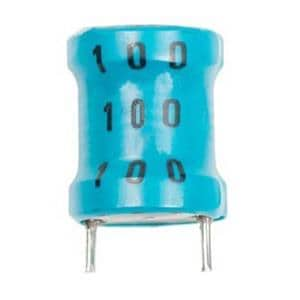

We select the core as ETD39.Īs we all know, when a 12 V battery is used, it's voltage is never constant. Here,the 310 V will be after rectification through a fast recovery bridge rectifier, and LC filters. We'll assume the output to be 310 V, which is normally the peak value of a 220V RMS. The frequency for switching the transformer will be 50 kHz, a typical figure in most SMPS inverters.
#Ferrite core inductor 470 how to#
How to Calculate Ferrite Core Inverter TransformerĬalculating a ferrite core transformer is actually quite simple, if you have all the specified parameters in hand.įor simplicity, we'll try to solve the formula through an example set up, let's say for a 250 watt transformer.
#Ferrite core inductor 470 full#
The only fundamental difference between the two is, the primary side of the center tap transformer has 2 times more number of turns than the Full bridge transformer. In both the forms the winding is applied with a continuously switching reverse-forward alternating current by the MOSFETs, oscillating at the specified high frequency, imitating a push-pull action. The push pull employs a center tap for the primary winding, while the full bridge consists a single winding for both primary and secondary.Īctually, both the topology are push-pull in nature. In switch mode inverters, normally two types of topology exits: push-pull, and Full bridge. Since higher frequencies allow proportionately lower number of turns, results in transformer being smaller, lighter and cheaper. Now you may think, why not use lower frequency as that would conversely help to reduce eddy currents? It appears valid, however, lower frequency would also mean increasing the number of turns for the same transformer. A magnetic material normally has a tendency to generate eddy current in response to a rising magnetic frequency.Īs the frequency is increased, eddy current also increases causing heating of the material and increase in coil impedance, which leads to further switching losses.įerrite cores, due to to their high magnetic permeability are able to work more efficiently with higher frequencies, due to lower eddy currents and lower switching losses. Meaning, when subjected to a magnetic field, ferrite material is able to achieve a very high degree of magnetization, better than all other forms of magnetic material.Ī higher magnetic permeability means, lower amount of eddy current and lower switching losses.

In contrast, ferrite cores possess very high magnetic permeability. It is because in iron core transformers, the iron material has much inferior magnetic permeability than ferrite material. Right, it is to achieve higher efficiency and compactness compared to iron core power supplies, but it would be interesting to know how ferrite cores allow us to achieve this high degree of efficiency and compactness? You might have often wondered the reason behind using ferrite cores in all modern switch mode power supplies or SMPS converters. Why Ferrite Core is used in High Frequency Converters The content is easy to understand, and can be very handy for engineers engaged in the field of power electronics, and manufacturing SMPS inverters. The post presents a detailed explanation regarding how to calculate and design customized ferrite core transformers.


 0 kommentar(er)
0 kommentar(er)
